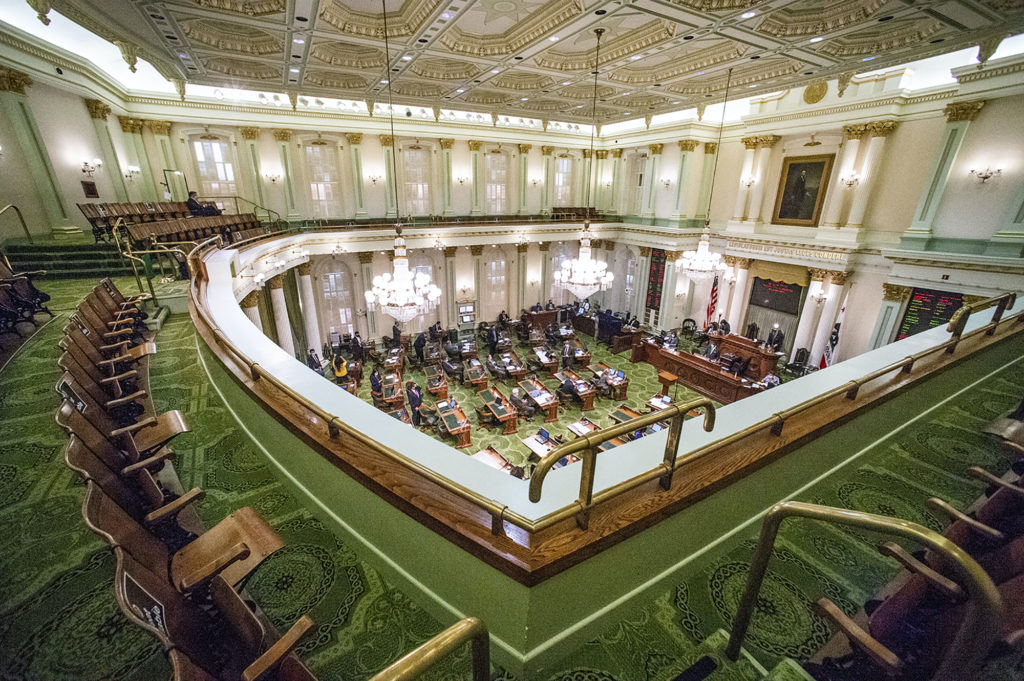
Black teachers: How to recruit them and make them stay

Lessons in higher education: What California can learn

Keeping California public university options open

Superintendents: Well-paid and walking away

The debt to degree connection

College in prison: How earning a degree can lead to a new life

Californians with a long memory will recall the time nearly a half century ago when the battle for state superintendent of public instruction was the hottest race on the state ballot — and the incumbent superintendent was one of the most polarizing figures in California’s history.
In the 1970 election, Wilson Riles took on conservative firebrand Max Rafferty, who had served two terms as schools chief and was running for a third. Rafferty was arguably the best known California politician, rivaled perhaps only by then-Gov. Ronald Reagan. In comparison, Riles was a virtually unknown deputy superintendent in the California Department of Education, appointed to that position ironically by Rafferty.
Drowned out by the political noise were some of the same educational challenges that California continues to grapple with today — how best to close achievement gaps, serve disabled students, involve parents in their child’s education, and ensure children read at an early age.
The Riles-Rafferty race offered a sharp contrast to the far-lower profile of today’s “down ballot” contest for state superintendent between Tony Thurmond and Marshall Tuck, in which many voters are expected to abstain from voting because they don’t know the candidates, or don’t care sufficiently about education to learn about them.
At the time, Riles was given no chance of winning. He had won just under 25 percent of the vote in the June primary, compared to Rafferty’s 48.6 percent, barely missing the 50 percent vote the incumbent needed to win outright in the nonpartisan race.
On top of that, Riles was African-American — and no African-American had ever been elected to statewide office in California.
Rafferty, a teacher, principal and school superintendent from Southern California, had become nationally known long before for a 1961 paper called “The Passing of the Patriot.” In it, he blamed public schools for “youngsters growing up to become booted, side-burned, ducktailed, unwashed, leather-jacketed slobs, whose favorite sport is ravaging little girls and stomping polio victims to death.”
He referred to what he called the “communist corruption” of the education system. He attacked the use of the Dictionary of Slang in school libraries, claiming it was a “handbook of sexual perversion” because it contained various obscenities in common usage.
His campaign slogan, “California schools need the fourth R: reading, ‘riting and ‘rithmetic, and RAFFERTY,” was known throughout the state. He denounced public schools for not teaching patriotism, and opposed teacher’s strikes, the teaching of evolution without being offset by creationism, and busing to achieve racial integration.
Rafferty would boast of “killing progressive education in California.”
But by 1970 Rafferty had alienated many of his fellow conservatives by running two years earlier for the U.S. Senate – against Sen. Thomas Kuchel, a popular moderate Republican. Rafferty beat him in the GOP primary, but then lost in the general election to Alan Cranston, the Democrat who then occupied the seat for the next 24 years.
Nonetheless, Rafferty was still endorsed by Reagan for the schools chief post against Riles — and also was praised and promoted by then-President Richard Nixon, who had Rafferty join him on the podium at an event in Southern California just days before the election.
In a remarkable upset, Riles easily defeated Rafferty. The New York Times, in its report on the California election, gave top billing to Riles’ triumph, which it described as “one of the most stunning upsets in California’s political history.”
In an overview of the campaign, political scientists Totten Anderson and Charles Bell praised Riles for pulling off “the most impressive performance in the fall campaign.”
By contrast, they described Reagan’s comfortable victory for a second term as governor over former Assembly Speaker Jesse Unruh as “the most lackluster gubernatorial campaign within memory.”
Riles went on to serve three terms. His legacy is evident in the school site councils he proposed, made up of teachers and parents that are still a feature of every school in California. He was also a prescient advocate of the importance of early education, and emphasized the importance of being able to read by the 3rd grade. He also created a master plan for special education at a time when schools barely served disabled children.
In another high profile electoral upset, Riles was himself ousted by Bill Honig in 1982 after serving three terms. Honig, a teacher and school superintendent in Marin County, and member of the State Board of Education, focused on persistently low test scores, especially of California’s high school students, and blamed Riles for failing to raise academic standards for graduation.
Even though the state superintendent’s position is a nonpartisan one, conflicts deepened between Honig, a Democrat, and George Deukmejian and Pete Wilson, the Republican governors during his tenure. The State Board of Education, whose members were appointed by Wilson, successfully went to court to strip Honig of the few powers he had. The impact of that court ruling is still evident today in the weakened status of the state superintendent. Honig was reelected twice, but was forced to step down after being found guilty of violating the state’s conflict of interest laws in a court case he and many of his supporters argued at the time was politically motivated.
One of the most noteworthy features of the current campaign for state superintendent is the amount of money spent trying to get Tuck or Thurmond elected. The latest tally suggests that spending on both sides — in the form of direct contributions to the candidates’ campaigns, independent expenditure committees, and issue ads by outside organizations — will top $60 million, with Thurmond being outspent by a more than a 2-to-1 margin.
That contrasts with the $609,000 spent by Riles — viewed as an exceedingly high amount at the time — and the $371,000 spent by Rafferty.
Also worth contemplating is that Riles remains the only African-American to hold the schools chief’s position. In fact, only two other other African-Americans have ascended to any statewide office in California since then: Lt. Gov. Mervyn Dymally, elected in 1974, and current Sen. Kamala Harris, elected in 2016.
Correction: This article was updated on Nov. 6 at 5 p.m. to indicate that in addition to Riles and Sen. Kamala Harris, Lt. Gov. Mervyn Dymally was the third African American to be elected to statewide office.

Panelists discussed dual admission as a solution for easing the longstanding challenges in California’s transfer system.

A grassroots campaign recalled two members of the Orange Unified School District in an election that cost more than half a million dollars.

Legislation that would remove one of the last tests teachers are required to take to earn a credential in California passed the Senate Education Committee.

Part-time instructors, many who work for decades off the tenure track and at a lower pay rate, have been called “apprentices to nowhere.”
Comments (4)
Comments Policy
We welcome your comments. All comments are moderated for civility, relevance and other considerations. Click here for EdSource's Comments Policy.
Stephen Talbot 5 years ago5 years ago
Very good article. I remember Max Rafferty all too well. As another has written here, Rafferty is the kind of right-wing kook, once very popular in Southern California, who most prefer to forget and pretend never existed. As a regular exercise in 1965-66, my high school English teacher in Los Angeles used to require our class to read Rafferty's weekly column in the then very conservative Los Angeles Times and critique his hyperbole, false statements … Read More
Very good article. I remember Max Rafferty all too well. As another has written here, Rafferty is the kind of right-wing kook, once very popular in Southern California, who most prefer to forget and pretend never existed. As a regular exercise in 1965-66, my high school English teacher in Los Angeles used to require our class to read Rafferty’s weekly column in the then very conservative Los Angeles Times and critique his hyperbole, false statements and extremist views. Rafferty used alliteration and bombast in much the same way that Nixon’s vice-president Spiro Agnew later would. When Rafferty ran for the U.S. Senate in 1968 against Alan Cranston, I did research for the Cranston campaign and discovered that as a student and fraternity leader at UCLA in the 1930s, Rafferty and his pals had a penchant for threatening and physically attacking student journalists at the Daily Bruin and labor and leftwing speakers who visited the campus. After losing to Cranston and then to Riles, Rafferty left California for Alabama where, at the time, he was more comfortable with the likes of segregationist George Wallace.
Sheldon Smith 5 years ago5 years ago
What about Willie Brown? Maybe a better definition of statewide office?
CarolineSF 5 years ago5 years ago
I remember my right-wing family supporting Rafferty, but that's definitely one of those things the conservative elders in the family now "forget" ever happened (with all due respect to my family, they're quite good at that). More recently, teachers overall really admired Honig. Since education "reformers" overall regard teachers with extreme contempt, presumably they would not be fans of his today. Read More
I remember my right-wing family supporting Rafferty, but that’s definitely one of those things the conservative elders in the family now “forget” ever happened (with all due respect to my family, they’re quite good at that).
More recently, teachers overall really admired Honig. Since education “reformers” overall regard teachers with extreme contempt, presumably they would not be fans of his today.
Lydia Bourne 5 years ago5 years ago
As I understand it, Mervyn Dymally, was Lt. Governor elected in 1975 and served until 1979. He was the second African – American elected to state wide office. Kamala Harris was the third, elected in first in 2010.